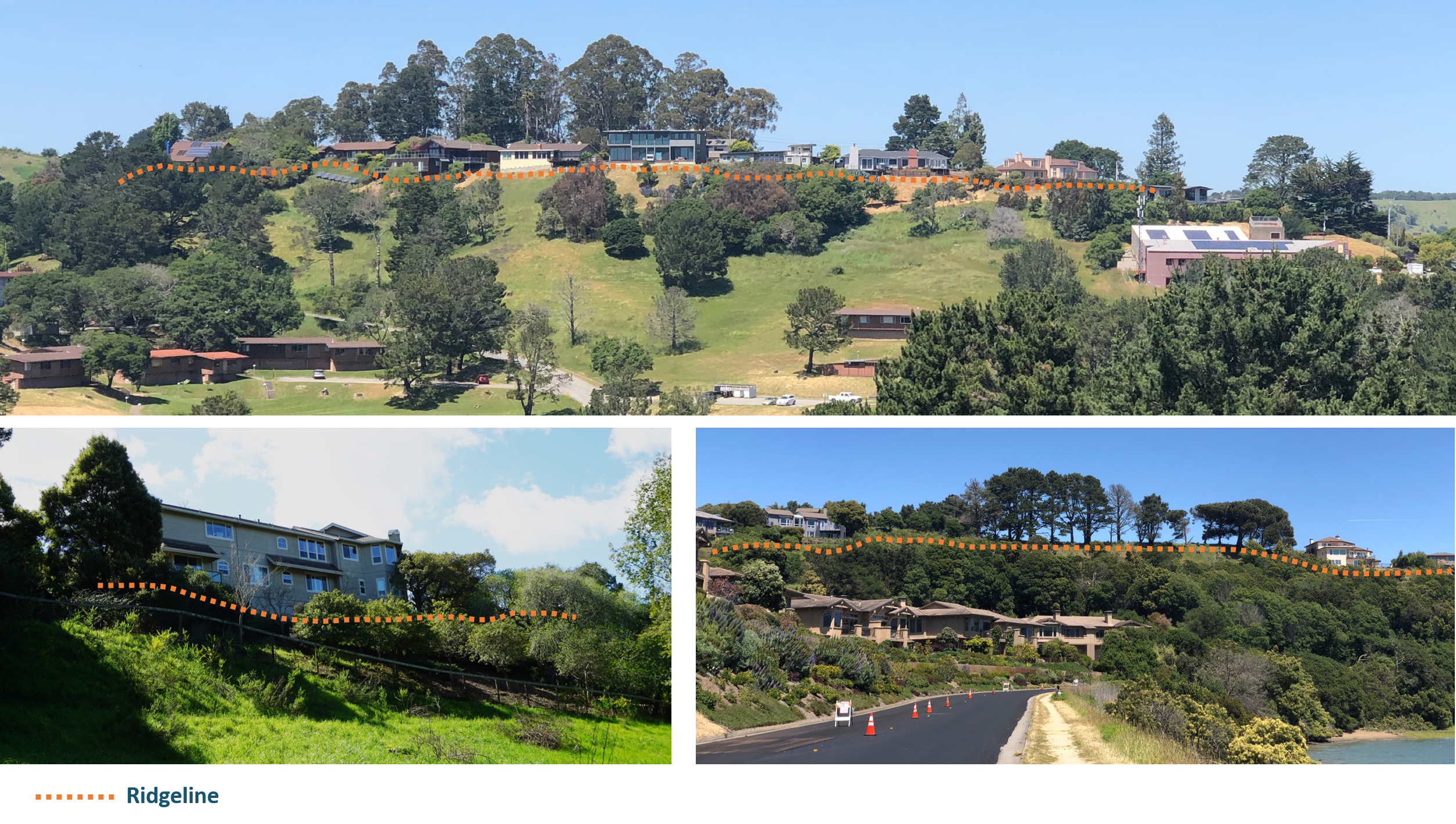Elements of the Design
Preserving the One Remaining Strawberry Ridgeline

In the decades following the creation of the Strawberry Community Plan, development has continued unabated along ridgelines throughout the area. Ridgelines along Richardson, Chapel, and Milland Drive, and De Silva Island, are dominated with structures situated along the crest of these ridges. Today, a portion of Chapel Drive on the Seminary property is the last undeveloped ridgeline on the peninsula. North Coast will preserve this small segment of open ridgeline with an accessible landscaped feature described here.
The Forested Knoll, a prominent elevated hilltop on Seminary Point will remain a protected open space as well.
Parking
An important focus of the plan is addressing the visual impact of cars and surface parking lots. Currently, all vehicles on the site are parked in surface lots. North Coast’s plan includes subterranean garages in most new residential structures and concealed garages in the duplex units.
The central parking lot will remain and serve the academic campus and users of the playing field, daycare and fitness center.
North Coast’s parking plan is part of a larger Complete Streets philosophy designed to encourage pedestrian and bicyclist activity while reducing the presence and reliance on vehicles.
Path of Travel for Pedestrians and Bicycles
The residential neighborhoods and academic campus will be accessible through a network of walkways and pedestrian-friendly streets. The pedestrian circulation throughout the site will be enhanced to give priority to people walking, not cars. The pedestrian bridge that crosses Herring Drive provides wheelchair/handicap access between the Residential Care Facility and the academic campus. Secured bicycle parking will be provided throughout the site.
Light Exposure
The existing exterior lighting throughout the site is inefficient and visually intrusive. North Coast’s plan incorporates the latest in lighting technology and minimizes light exposure from the property while ensuring that internal streets and pathways are safe and well lit. The plan incorporates low-wattage fixtures, directed downward and shielded to prevent adverse impact to neighbors.
The proposed Seminary Point housing is set behind and below the native tree-line with screening and window placement designed to minimize light exposure westward.
Setbacks and Fences
In the Strawberry area, typical setback of structures from property lines is ten feet and a typical Strawberry property is surrounded by a solid, six-foot high fence with individual front and backyards. Unmanaged landscaping frequently encroaches onto sidewalks, forcing pedestrians onto the street and potentially unsafe conditions.
North Coast’s project contains no fence around its property line, no individual yards, and no fences between housing units. A managed, long-term landscaping plan will ensure that pedestrian pathways are clear of obstacles. Surrounding neighbors will be able to take advantage of the site’s perimeter open space.
Roof Treatments
Recently built residential developments in Marin County have set a precedent for obtrusive rooftop elements that generally detract from the aesthetic of the building, a precedent North Coast is committed to avoid.
All proposed structures in North Coast’s redevelopment plan are designed to minimize any rooftop components by:
- Centralizing vents
- Utilizing hydronic heating systems to eliminate the need for air conditioning
- Clustering all mechanical equipment along the walls of the subterranean garages
In addition, North Coast’s redevelopment plan will incorporate environmentally conscious technologies such as photovoltaic panels that can be installed on building roofs and hidden behind parapets to reduce visual impacts.
Landscaping
The existing landscape includes a mix of native and non-native trees, native and non-native underbrush and primarily non-native grasses. The Monterey pines planted throughout the Site in the 1960’s are nearing the end of their lifespan. North Coast’s plan includes a long-term program to remove dead and declining trees and replant native and compatible species. The general approach to landscape will be to remove exotic and invasive species and to restore an open, native oak and grassland landscape.
Plants will be arranged to ensure no connectivity between shrub understory plantings and tree crowns. Tree planting will include clusters of native oaks, buckeye or compatible ornamental species spaced so that mature crowns will be well separated at maturity. Existing trees within the 30-foot defensible space zone from buildings will be pruned of all dead wood and branches. Healthy Monterey pines within the 30-foot zone will be retained and pruned. Pines determined to be unsuitable for preservation will be removed. The site’s landscape will be maintained to ensure a fire-safe condition, consistent with Marin County Fire Department regulations.
All permanent irrigation for new landscape areas near walkways, building foundations, planters and campus grounds will be drip irrigated. All shrub and groundcover areas will be mulched to retain soil moisture. Subsequent landscape improvement plans and specifications will include detailed maintenance requirements.
The design of the Residential Areas eliminates individual yards, thus reducing the waste of potable water through efficient technologies, conservation efforts, design and management practices, and by better matching the source and quality of water to the user’s needs.
In addition, the proposed project will include a new storm drain system including vegetated and cobble swales, drainage inlets, storm drain piping, and storm water best management practices including treatment and detention.